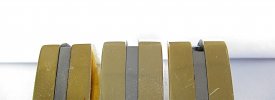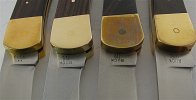dsutton24
Gold Member
- Joined
- Apr 9, 2018
- Messages
- 2,131
Once again I'm down the Buck 110 V5 rabbit hole. Is there a definitive way to identify a forged or sintered frame? I've got knives that span this era, and I've never really been able to tell them apart. The frames were machined, then cast for a long time, then forged, then sintered. It's that brief forged to sintered frame transition period I'm wondering about. I know that somewhere around the 2 dot era the frames were sintered, the scales are not glued, and the grind lines disappear from the liners.
For example, a recent acquisition. Stamped BUCK / 110 / U.S.A.. It has two small scale rivets, the butt end rivet is offset away from the lock bar side of the knife. The scales are glued, and grind marks are visible on the inside liner surfaces. How do I identify it as forged vs. sintered?
For example, a recent acquisition. Stamped BUCK / 110 / U.S.A.. It has two small scale rivets, the butt end rivet is offset away from the lock bar side of the knife. The scales are glued, and grind marks are visible on the inside liner surfaces. How do I identify it as forged vs. sintered?


